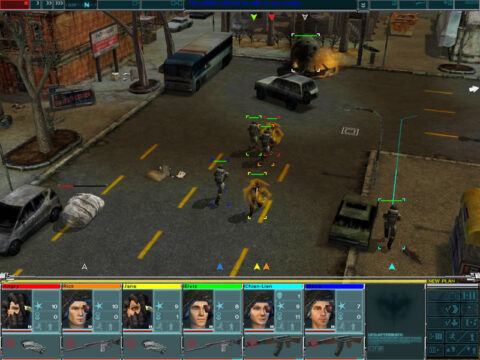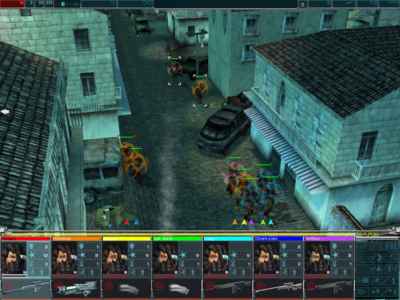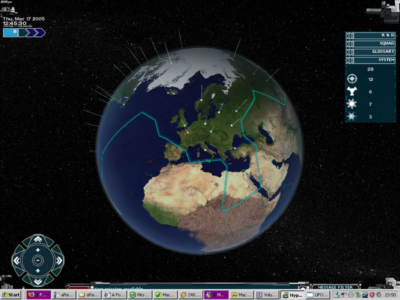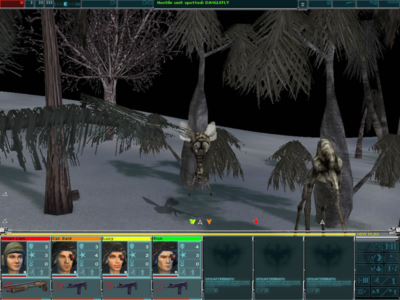
UFO Aftermath
Written by: Stoo
Date posted: October 28, 2006
- Genre: Strategy
- Developed by: Altar
- Published by: Cenega
- Year released: 2003
- Our score: 7
Let’s suppose we were to take a survey of those who were into PC gaming back in the early 90s. We’re talking a set of people well into their 20s or 30s now, with a touch of nostalgia for those days of VGA and midi music. Putting a line at 1995 (before such modern innovations as 3D acceleration), and asking for lists of favourite games up to that point , I’d be willing to bet money that UFO: Enemy Unknown would fare pretty well. A strategy favourite from 1993, it had many of us hunched before our computers for entire weekends, shunning sunlight in an unhealthy manner. Even today it’s pretty enjoyable, if you can live with the clunky VGA graphics.
Putting the player as commander of an elite military force, the mission was to fight off alien invaders. It had two main components; at its heart were turn based battles pitting your squad of elite soldiers against aliens at their hidden bases, UFO crash sites and even city streets. Linking these was a global strategy and resource-management overview. The formula worked, and UFO was thus quite a success. It kicked off the X-Com series, the next two of which were quite worthy followers. The first sequel took the battles underwater, and the second focussed on a single city. Unfortunately from there the series trailed off into a sub-bar space-sim and a cynical cash in of a shooter. There were a few attempts underway to revive it, towards the end of the decade, but sadly they were never completed. The series’ popularity endured, however, and there was certainly a demand for some kind of continuation.
Then in 2003, developers Altar brought us UFO: Aftermath. It’s not an official relation to X-com but, being obviously heavily inspired by the original Enemy Unknown, could definitely be called a spiritual heir. Although Altar claimed they were following their own plan, instead of just making an unofficial X-com of their own, it follows the same themes and structure quite closely. Once again you’re dividing your your time between battles and a strategy overview, with other key factors being researching new wargear and building your squad from newbies to killer veterans.
So then, a kind of re-imagined UFO for modern gamers. Or, nearly modern. Aftermath is three years old now, which given the pace at which gaming technology moves on, means it just about comes within our sights as an ‘old game’ in its own right. Not an oldie in the same way as the old X-com games of course, but I’m pretty certain it would pass the ‘run on a 5 year old PC’ test at least. So it’s valid material for an article here, even if only narrowly qualifying. Also, I’m always interested in games aiming to be successors (even in an unofficial capacity) to favourites from the old days.
Anyway that’s enough context, let’s look at the game itself. Set in the near future, mankind verges on total defeat following a sudden alien attack. Some kind of toxin or virus was released into the atmosphere, wiping out most life, and the only survivors were those who could find shelter underground. A few weeks later when the air had cleared, they resurfaced to find the earth devastated and hideous mutants prowling the ruins. Banding together, the remnants of humanity have pooled their resources to form a military force, with the aim of somehow defeating the alien threat and reclaiming the planet.
The strategic overview will be instantly familiar to X-Com fans – planet earth, hanging in space before you. Here you can see your bases, and outlines of territory you control. From time to time missions for your troops will appear on the globe – such clearing out an area of aliens, conducting reconnaissance, or more significantly assaulting the enemy’s own bases. Detected UFOs also appear; you can send interceptors to shoot them down, and if successful send troops to investigate the crash site.
Winning these missions brings more territory under your control – and captured bases can be turned over to your own use. However, you only have one squad, and it takes them a while to reach any one mission, while missions will only be available for a finite period. So you’re sometimes forced to make an executive decision and choose between a couple. Missions you don’t have time for (or can’t be bothered with) will be taken care of by other forces. However you have no input on this, you’re just informed of whether or not they’re successful. Also you miss the chance to salvage wargear, or build up your troops.
Here you also put your organizations’ scientists to use. You might start out outgunned, outmatched and with little idea of what the Aliens are really up to, but in true X-com style your boffins will help even the odds. The most obvious use for them is looking over alien weaponry, to fathom out how it works, but there are other goals too. Analysis of aliens to learn how to better fight them, pouring over UFO technology that might be adapted for your jet interceptors, and also gaining some broader idea as to the aliens goals.
What does come as a surprise to an X-com veteran, however, is the relative lack of resource management. For one thing there’s no economy in this game – no money, no income, no expenses. Balancing your books and keeping a healthy income is no longer a concern. The only resources that need watching are troops themselves – new ones periodically being granted to you – and their equipment. Weapons and armour are either scavenged from bases you capture, or manufactured at your own bases. There’s no cost to the latter so the only limit to what you churn out is what you have time for.
Base management is also heavily simplified. You get three kinds: the first of which are military bases for launching attacks (you get an unlimited supply of interceptors for downing UFOs). Meanwhile scientific and engineering bases contribute to your overall research and manufacturing output respectively. They can’t be given individual tasks, so must all pitch in collectively to the same project, with more bases meaning faster progress. Also there’s none of the control over individual base capabilities, facilities and staff that featured in X-Com – in effect bases are just dots on a map.
I’m speaking fairly critically here. My guess is that Altar didn’t want their game slowed down with fiddling over resources, and thus went for a more slick and straightforward overview between missions. There is a case for that approach, certainly. Still, a large portion of the geeky fun of the X-com was playing around with details like building extra sleeping quarters and research labs. Or mulling over a purchase order of equipment and deciding whether or not you could afford some extra rocket launchers, and what effect hiring some engineers would have on this month’s budget. So for the veterans, it does feel like something is missing.
Anyway, onto the battles themselves. They’re in real-time, but with frequent pauses. In fact just about any event – completing a move order, seeing an enemy, killing it, taking hits – is a trigger for the action to halt. Sometimes that can become a little frustrating, but that’s largely down to way the troops loudly squawk for your attention, their lines delivered with some fairly crummy voice-acting. Also commands can be queued, so remember to hit w for ‘wait’ after a move command, you’ll be spared six or seven variants of “I REQUIRE ORDERS” when they reach their destination
The action takes place in a range of areas: sometimes forests or farms, other urban zones. The graphics are a little sub-par for 2003 perhaps but we’re not really going to dwell on that on an oldies site. More annoying for me was that you can’t enter buildings. Oh, and you can’t damage them either. Still the game provides some decent environments, with a bit of atmosphere to them. There’s something a little creepy about the deserted cities, a reminder of how humanity is now driven to near-extinction, and now horrible things lurk amidst the shops and apartment blocks. A nice touch is that the urban styles do vary depending on where you are – North America, Europe, Middle east etc.
Battles tend to start out with a kind of uneasy quiet, your men creeping about under your wary guidance, but given the fairly small size of many maps, something nasty will be charging or shooting at you before long. Here’s where things get really tense, as you hastily reposition men, get the heavy weapons guy in position, try and get the wounded out of the way and so on. The frequent pauses might actually start to make sense here, as you’ll probably want to reconsider your orders with every new development, anyway.
Rural areas are pretty easy to clear out – multiple enemies are normally revealed in seconds, and you can immediately let rip with a storm of fire. Urban fights are tougher, with monsters scattered behind cover and surprising you at short range. By far the hardest, however are alien base assaults. These claustrophobic affairs where a just couple of heavily-armed little bastards can wreak havoc. In fact you’ll sometimes find yourself getting thrashed in short order, so might want to abort and retry. So a large degree of patience and persistence is required for success – it did actually frustrate me to the point of giving up at times.
Your enemies, as it turns out, come in two types. First there’s the transgenants – twisted mutant creatures somehow produced from earth creatures, including humans. Imagine cancerous lumps of acid-spitting flesh, giant translucent maggots formed around a mummified corpse, and some still human enough to wield guns. Pretty nightmarish stuff, although most of them aren’t too hard to kill. The aliens themselves are far more challenging foes, these are the ones with the advanced weapons and armour.
In fact when it comes to weaponry, there’s an impressively wide selection. Starting with the modern-day earth weapons, you’ll find a huge selection of pistols, rifles and shotguns. All of which are taken from real life, so it should be enough to make any gun-nut nod in approval. Along with these go alien weapons that you plunder – lasers, plasma guns and weird psionic guns. The first lasers you go up against are quite effective, so you’ll probably feel quite pleased with yourself when you grab some of your own and turn them on those alien bastards. Except then the bastards wheel out even nastier weapons. So right up until the end of the game you’ll be kept on your toes.
A key point is, each weapon inflicts a certain type of damage, from a list of about seven. Conventional bullets might do hard, soft or universal damage, plus there’s laser, plasma, fire, and a few more. Your troops can wear armour to protect against this, and eventually you learn how to copy alien armour too, but most armours are only effective against a few damage types. So a key part of tactics is planning ahead as to what arms and armour you think you’ll need, and how to best counter what you expect the enemy to throw at you.
In the longer term, building up the quality of your troops is an important factor, especially as new recruits are relatively rare. They have a number of attributes, the most immediately important being accuracy with various weapon types like pistols, assault rifles and heavy launchers. Others include observation (how far off they can spot aliens), dodging and carrying capacity. These are all based off core attributes like strength and dexterity, which improve with time and experience in battle. All these skills and stats might seem a little RPG-esque, but it’s pretty straightforward nonetheless. A nice improvement on the original format is that you can also send troops not on missions to do some training, so they’re not just twiddling their thumbs.
This whole review has largely consisted of a step-by-step comparison to Enemy Unknown and I wonder, if a member of Altar was to read this, would they find that frustrating? After all they might argue that the original was their inspiration, not something they were trying to replicate. However, this site is supposed to be for oldies fans, and I think it’s inevitable that we will view this game in how it succeeds or fails compared to either the original, or what we would expect of a modern reworking of that old favourite. You might also say that, given how in several important ways this does keep pretty close to the UFO format, for all Altar’s claims, it’s only fair that we make a note of the deviations, especially when they seem to be not always for the better.
At any rate, given the perspective I’m taking here we’re left with the question of, is this a worthy successor to our old favourite? Well, more or less. It’s not the triumphant return of X-Com, even an unofficial one, that I’d hoped for, so I guess we old-school nerds will have to wait a little longer. However it doesn’t fall drastically short of the mark, and it’s still pretty a solid, enjoyable piece of squad combat. Although I’m not as impressed as I’d hoped I’d be, remember the criteria it’s being held against are A: pretty high and B: let’s not kid ourselves, boosted a least a little by nostalgia. So in short, not quite a classic, but certainly worth the £10 I spent.





 Posts
Posts